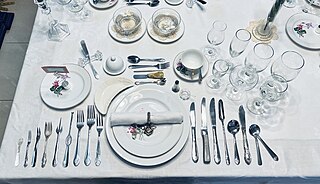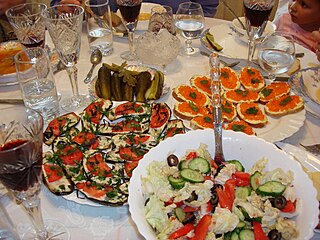The following outline is provided as an overview of and topical guide to meals:
An hors d'oeuvre, appetiser or starter is a small dish served before a meal in European cuisine. Some hors d'oeuvres are served cold, others hot. Hors d'oeuvres may be served at the dinner table as a part of the meal, or they may be served before seating, such as at a reception or cocktail party. Formerly, hors d'oeuvres were also served between courses. There are two types of hors d'oeuvre from service point of view:
- General hors d'oeuvre
- Classical hors d'oeuvre

Meze is a selection of small dishes served as appetizers in Albanian, Bosnian, Armenian, Kurdish, Levantine, Turkish, Bulgarian, Greek, Iraqi, Egyptian, Balkan, Caucasian and Persian cuisine, to name a few. It is similar to Spanish tapas and Italian antipasti. A mezze may be served as a part of a multi-course meal or form a meal in itself. In non-Islamic countries, or in areas without alcohol restrictions, mezze are often served with spirits such as arak, raki, oghi or grappa.

A canapé is a type of starter, a small, prepared, and often decorative food, consisting of a small piece of bread or cracker, wrapped or topped with some savoury food, held in the fingers and often eaten in one bite.
Apéritifs and digestifs are drinks, typically alcoholic, that are normally served before (apéritif) or after (digestif) a meal respectively.
An entrée, in modern French table service and that of much of the English-speaking world, is a dish served before the main course of a meal. Outside North America, it is generally synonymous with the terms hors d'oeuvre, appetizer, or starter. It may be the first dish served, or it may follow a soup or other small dish or dishes.

An amuse-bouche or amuse-gueule is a single, bite-sized hors d'œuvre. Amuse-bouches are different from appetizers in that they are not ordered from a menu by patrons but are served free and according to the chef's selection alone. These are served both to prepare the guest for the meal and to offer a glimpse of the chef's style.

A full-course dinner is a meal with multiple courses, almost invariably eaten in the evening or afternoon. Most Western-world multicourse meals follow a standard sequence, influenced by traditional French haute cuisine. It commonly begins with an appetizer, followed by the main course, the salad course, and eventually the dessert, but the exact sequence varies widely. Full-course dinners are generally very formal as well as very expensive, and can have as little as 3 or as many as 21 courses. Some major styles include service à la russe and service à la française.

Prawn cocktail, also known as shrimp cocktail, is a seafood dish consisting of shelled, cooked prawns in a Marie Rose sauce or cocktail sauce, served in a glass. It was the most popular hors d'œuvre in Great Britain, as well as in the United States, from the 1960s to the late 1980s. According to the English food writer Nigel Slater, the prawn cocktail "has spent most of see-sawing from the height of fashion to the laughably passé" and is now often served with a degree of irony.

A pu pu platter is a tray of American Chinese or Hawaiian food consisting of an assortment of small meat and seafood appetizers. The Thrillist called the pu-pu platter "an amalgam of Americanized Chinese food, Hawaiian tradition and bar food."
Brigade de cuisine is a system of hierarchy found in restaurants and hotels employing extensive staff, commonly referred to as "kitchen staff" in English-speaking countries.
The historical form of service à la russe is a manner of dining with courses brought to the table sequentially, and the food portioned on individual plates by the waiter. It contrasts with the older service à la française, based on several courses brought to the table simultaneously, in an impressive display of tureens and serving dishes, with diners plating food themselves.

A vol-au-vent is a small hollow case of puff pastry. It was formerly also called a patty case.

Angels on horseback is a hot hors d'œuvre or savoury made of oysters wrapped with bacon. The dish, when served atop breads, can also be a canapé.

A drinking establishment is a business whose primary function is the serving of alcoholic beverages for consumption on the premises. Some establishments may also serve food, or have entertainment, but their main purpose is to serve alcoholic beverages. There are different types of drinking establishment ranging from seedy bars or nightclubs, sometimes termed "dive bars", to 5,000 seat beer halls and elegant places of entertainment for the elite. A public house, informally known as a "pub", is an establishment licensed to serve alcoholic drinks for consumption on the premises in countries and regions of British influence. Although the terms are increasingly used to refer to the same thing, there is a difference between pubs, bars, inns, taverns and lounges where alcohol is served commercially. A tavern or pot-house is, loosely, a place of business where people gather to drink alcoholic beverages and, more than likely, also be served food, though not licensed to put up guests. The word derives from the Latin taberna and the Greek ταβέρνα/taverna.

Zakuski is an assortment of cold hors d'oeuvres, entrées and snacks in food culture in Slavic-speaking countries. It is served as a course on its own or "intended to follow each shot of vodka or another alcoholic drink". The word literally means 'something to bite after'. It probably originated and was influenced through the fusion of Slavic, Viking-Nordic and Oriental cultures in early Rus' regions like the Novgorod Republic.

A crab puff is a ball of crab meat, mixed with flour, egg, and seasonings, that has been deep-fried in batter. They are often served in restaurants as an appetizer or side dish. They may be served alone, or with any of a variety of sauces, such as tartar sauce, cocktail sauce, or sweet and sour sauce.
The 2010s in food in the United States describes food trends that are characteristic of the 2010s decade. Many of the trends are a direct result of related social or economic events.

Kap klaem, also known as ahan kap klaem or ahan klaem lao, is the Thai term for "drinking food": foods commonly eaten while drinking. The term kap klaem can also refer to Thai drinking culture.















